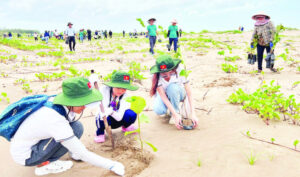Houses on stilts rested under the shadow of big trees, surrounded by paddy fields. Our curious eyes seemed not to bother the chickens who walked freely on simple bamboo fences. A small cement path led us to houses where we could see how Muong people garden, raise poultry, weave and cook.
The northern province of Hoa Binh has long been home to Muong ethnic people. Although the province is not far from the capital, the Muong culture has many special features that distinguish it from majority Kinh society. Visiting Giang Mo Village, I experienced this culture firsthand. Set in a valley at the foot of Mo Mountain in Cao Phong District, 85km northwest of Ha Noi and 10km from Hoa Binh City, the village has been a popular tourist destination for more than 20 years. Walking along the path, I saw children on high bamboo stilts and playing folk games like shuttle throwing. Some of them invited us to try the games. Taking a deep breath of fresh air, I felt as if I had escaped to a more tranquil world.
I stepped inside local Bui Kim Dinh's house, where she told me about Muong gong culture. Showing me a set of 12 gongs symbolising the 12 months of the year, she said each family in the village owned at least one gong handed down through generations. On New Year's Eve, people beat that gong to invite their ancestors to join the festivities.
"Gongs are not simply musical instruments," Dinh said. "People treat them like living bodies with souls and deep understanding." She explained that the gongs are used for various purposes throughout the year. Gongs are beaten when a host welcomes guests to festivals, parties and weddings, and to welcome the new year. A team of women travel throughout the village, singing and beating gongs to wish people a happy new year and ward off bad things, as the long-lasting echo is believed to scare away evil. The gongs also have a utilitarian purpose. When a person in the village wants to build a house, he must gather lots of tree trunks and bamboo. Neighbours work together, using gongs to motivate each other.<
Gongs are also used during huntings to scare wild animals. When hunting ends, people beat gongs to announce the victory to the whole village. If the sounds last a long time, the message is that the men caught lots of animals and are inviting people to come enjoy the bounty.
Of course, the gong is also a musical instrument.
"Learning to play the gong is not difficult," she said. "The biggest challenge is for all the gong beaters to work together to create a perfect melody."
Muong cuisine is also fascinating to experience. The tribe used to live in valleys surrounded with lime mountains, near small rivers and streams, so their lives still rely significantly on nature and they remain almost self-sufficient.
Local Bui Thi Luu showed me how to steam rice in a piece of bamboo. The rice was carefully washed, mixed with peanuts and put into a bamboo trunk, which was then covered with a banana leaf and steamed. Muong people steam fish, vegetables and pork in the same way. The method preserves the freshness and sweetness of the ingredients.
Dinh said there was a saying among Muong people: "We show love through words; we show respect through our eating habits." While eating, elder people always sit higher than younger ones, while a guest invited to a cup of wine should drink the whole thing in one go to express his or her sincerity to the hosts.
People tend to serve their food in banana leaves, which are then placed on a bamboo tray, rather than putting them on dishes. Sitting next to the fire and eating from the banana leaves, I felt the essence of forest and mountain, which was added to by a few sips of rice wine infused with leaves from the tro trang tree.
Leaving the village, I was drunk, not only with the special wine, but also with the echo of gongs and aroma of food of this unique culture.
















